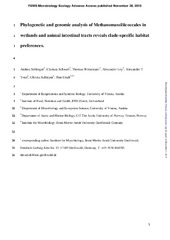| dc.contributor.author | Söllinger, Andrea | |
| dc.contributor.author | Schwab, Clarissa | |
| dc.contributor.author | Weinmaier, Thomas | |
| dc.contributor.author | Loy, Alexander | |
| dc.contributor.author | Tveit, Alexander Tøsdal | |
| dc.contributor.author | Schleper, Christa | |
| dc.contributor.author | Urich, Tim | |
| dc.date.accessioned | 2016-02-19T12:56:34Z | |
| dc.date.available | 2016-11-27T06:50:04Z | |
| dc.date.issued | 2015-11-27 | |
| dc.description.abstract | Methanogenic Thermoplasmata of the novel order Methanomassiliicoccales were recently discovered in human and animal gastro-intestinal tracts (GITs). However, their distribution in other methanogenic environments has not been addressed systematically. Here, we surveyed Methanomassiliicoccales presence in wetland soils, a globally important source of methane emissions to the atmosphere, and in the GITs of different animals by PCR targeting their 16S rRNA and methyl:coenzyme M reductase (α-subunit) genes. We detected Methanomassiliicoccales in all 16 peat soils investigated, indicating their wide distribution in these habitats. Additionally, we detected their genes in various animal faeces. Methanomassiliicoccales were subdivided in two broad phylogenetic clades designated ‘environmental’ and ‘GIT’ clades based on differential, although non-exclusive, habitat preferences of their members. A well-supported cluster within the environmental clade comprised more than 80% of all wetland 16S rRNA gene sequences. Metagenome assembly from bovine rumen fluid enrichments resulted in two almost complete genomes of both Methanomassiliicoccales clades. Comparative genomics revealed that members of the environmental clade contain larger genomes and a higher number of genes encoding anti-oxidative enzymes than animal GIT clade representatives. This study highlights the wide distribution of Methanomassiliicoccales in wetlands, which suggests that they contribute to methane emissions from these climate-relevant ecosystems. | en_US |
| dc.description | This is the accepted manuscript version. Published version available at <a href=http://dx.doi.org/10.1093/femsec/fiv149>http://dx.doi.org/10.1093/femsec/fiv149</a> | en_US |
| dc.identifier.citation | FEMS Microbiology Ecology, 92, 2016, fiv149 | en_US |
| dc.identifier.cristinID | FRIDAID 1295553 | |
| dc.identifier.doi | http://dx.doi.org/10.1093/femsec/fiv149 | |
| dc.identifier.issn | 0168-6496 | |
| dc.identifier.uri | https://hdl.handle.net/10037/8522 | |
| dc.identifier.urn | URN:NBN:no-uit_munin_8084 | |
| dc.language.iso | eng | en_US |
| dc.publisher | Oxford University Press | en_US |
| dc.rights.accessRights | openAccess | |
| dc.subject | VDP::Matematikk og Naturvitenskap: 400::Basale biofag: 470::Generell mikrobiologi: 472 | en_US |
| dc.subject | VDP::Mathematics and natural science: 400::Basic biosciences: 470::General microbiology: 472 | en_US |
| dc.subject | methanogens | en_US |
| dc.subject | archaea | en_US |
| dc.subject | peat soil | en_US |
| dc.subject | methylotrophic methanogenesis | en_US |
| dc.subject | enrichments | en_US |
| dc.subject | metagenomics | en_US |
| dc.title | Phylogenetic and genomic analysis of Methanomassiliicoccales in wetlands and animal intestinal tracts reveals clade-specific habitat preferences | en_US |
| dc.type | Journal article | en_US |
| dc.type | Tidsskriftartikkel | en_US |
| dc.type | Peer reviewed | en_US |


 English
English norsk
norsk